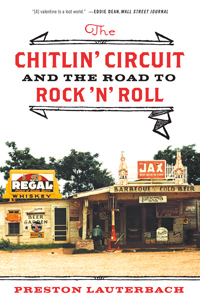Memphis music geography centers on Beale Street downtown, but blues, jazz, rock ‘n’ roll, and soul have spilled out onto Thomas Street in the section of North Memphis called New Chicago since before WWII. It manages to stay well-hidden from the rest of the city– it’s not on the approved list of tourist attractions despite a rich history and thriving present music scene.
 The urban renewal that smashed Beale never reached Thomas. The clubs on the strip today are in buildings constructed in the 1920s, which give the place an even more authentic feel. Thomas Street boasts a bounty of cultural treasure, from the vacant site of American Recording Studio at 827, to civil rights activist and fire barber Warren Lewis’ salon at 887, the beautiful One Block North juke joint at Thomas and Marble Avenue, on up to CC Blues Club at 1427. Isaac Hayes called the neighborhood home while a student at New Chicago’s Manassas High School, off Thomas Street on Firestone Avenue.
The urban renewal that smashed Beale never reached Thomas. The clubs on the strip today are in buildings constructed in the 1920s, which give the place an even more authentic feel. Thomas Street boasts a bounty of cultural treasure, from the vacant site of American Recording Studio at 827, to civil rights activist and fire barber Warren Lewis’ salon at 887, the beautiful One Block North juke joint at Thomas and Marble Avenue, on up to CC Blues Club at 1427. Isaac Hayes called the neighborhood home while a student at New Chicago’s Manassas High School, off Thomas Street on Firestone Avenue.
In the middle of these stories sits the site of Currie’s Club Tropicana at 1331 Thomas, pictured at left. The brick building here was built in 1951, though a frame building at the same address held the club prior to that. Johnnie Currie ruled the North Memphis night from 1946 to the 1970s, with the exception of a five year period spent on Beale.
Currie’s club hosted big-time touring R&B acts like Fats Domino, Louis Jordan, Bill Doggett, Hank Ballard and the Midnighters, Ray Charles, Little Junior Parker. “Mr. Currie brought the biggest,” recalled drummer Howard Grimes, who joined the Currie’s houseband in the late 1950s.
The Ernest Withers photos at right give us a glimpse inside Currie’s. They appeared in the August 15, 1955 addition of the Memphis Tri-State Defender.
In addition to Grimes, the houseband included tenor sax player Emerson Able, alto Floyd Newman, trumpeter Herman Green, bassist Robert McGee, pianist Eddie Jones, guitarist Clarence Nelson, and leader Ben Branch.
Currie’s is also remembered as the location of an auspicious debut. “Ben Branch didn’t like Isaac Hayes for some reason,” Grimes remembers. “Isaac was in the house and asked Ben would he let him sing, and Ben wouldn’t let him. Word got to Mr. Currie, and he got on Ben’s case. When we took a break, I saw them arguing in the kitchen. Currie told Ben if he wouldn’t let Isaac sing, he wouldn’t have a job. I’ll never forget the song Isaac sang that night, Brook Benton’s ‘Just a Matter of Time.’ We had been practicing because Brook Benton to come to town. They called Isaac up to sing and he brought the house down. It turned his life around. Everybody was talking about it the next day.”
Currie left his club around 1965 to run the Hippodrome at 500 Beale Street. He sold to Clyde Hopkins, a former member of the W.C. Handy orchestra, and Hopkins’ mother “Big Baby,” who ran roadhouses in Tunica, Mississippi while raising her son. “My mother would run the cafe, and cook,” recalls Hopkins. “I had every musician that you can name to play there. You had to call them and book them. You got to pay them a guarantee. I named it Club El Morocco. Back then, anyone getting $1,000 to $1,200 was getting good money. We had seating capacity of 1400. Most of the time I used Ted Taylor as my houseband, you ever hear of him? He sang and played a little guitar. He got killed in a car wreck.”
Currie came back around 1970, purchased the club back from Hopkins and uptowned the name:
Currie died, probably in 1979, a year after his wife Suzie passed.
The creativity still flows through 1331 Thomas Street. Today the club Johnnie Currie built houses the studio of artist Nelson Smith III. He creates giant plaster sculptures and molds for fiberglass statues, a trade he learned as the fiberglass sculptor of Shoney’s Big Boy mascots in the area. When I last visited, Nelson was working on modifying a Pontiac Firebird with plaster to resemble a DeLorean.
Like this:
Like Loading...
Tags: Chitlin' Circuit, Clubs, History, Isaac Hayes, Memphis

 And what a fun lineup from June 1948:
And what a fun lineup from June 1948: Would have been a ball to catch Memphis Slim there in August ’48, battling his blues against the bebop of Herb Hardesty’s trio.
Would have been a ball to catch Memphis Slim there in August ’48, battling his blues against the bebop of Herb Hardesty’s trio. To see today’s stars of New Orleans drag entertainment, you absolutely gotta visit .
To see today’s stars of New Orleans drag entertainment, you absolutely gotta visit .






